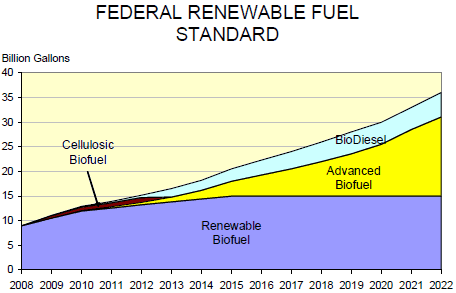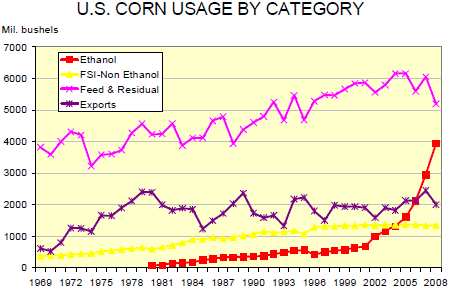



CME: Governor Parry's RFS Waiver Request Denied
US - CME's Daily Livestock Report for 7 August 2008.EPA Administrator Stephen Johnson has announced that the agency has denied Texas Governor Rick Parry’s request for a partial waiver of the Renewable Fuels Standard.
| E-Livestock Volume | 8/7/08 | 8/6/08 | 7/31/08 |
|---|---|---|---|
| LE (E-Live Cattle): | 23,587 | 23,959 | 11,856 |
| GF (E-Feeder Cattle): | 1,635 | 1,414 | 1,367 |
| HE (E-Lean Hogs): | 16,938 | 18,089 | 18,219 |
The news, though disappointing to livestock producers, was not unexpected given ethanol output levels and the recent decline of corn prices that we highlighted in yesterday’s Daily Livestock Report.
The top chart shows the usage levels that last December’s energy legislation requires for various biofuels through 2022. Some definitions of the various mandated products other than biodiesel might be useful.
- Renewable biofuels are basically conventional ethanol made from corn starch. The mandate requires blenders to use 9 billion gallons this year, 10.5 billion next year and, ultimately 15 billion gallons per year in 2015 and beyond.
- Cellulosic biofuel is any biofuel derived from any form of cellulose that comes from renewable biomass and achieves a 60% greenhouse gas (GHG) reduction.
- Advanced biofuels are any biofuels other than corn starch ethanol that achieve a 60% GHG reduction.
Administrator Johnson stated in a press release: “After reviewing the facts, it was clear this request did not meet the criteria in the law.” EPA is authorized to waive the national RFS if the agency determines that the mandated biofuel volumes would cause “severe harm” to the economy or the environment. Johnson maintained in a conference call that the “severe harm” criteria was not met but did not address Governor Parry’s claims of severe damage to the livestock industry. Johnson did point out that EPA looked at livestock production and found that feed prices have increased because of biofuel production but then asked". . Is that the result of the RFS mandate? Our conclusion is no.”
The first conclusion is a bit comforting for livestock producers since several government officials, the ethanol and corn lobbies and even some prominent farm groups have repeatedly claimed that using corn to make ethanol is not the reason for higher corn prices. The bottom graph seems to fly in the face of that argument and agree with EPA. Food, seed and industrial (FSI) usage other than ethanol for 2007/08 is 0.5% lower than its 10-year average. Feed and residual usage is only 4% higher. Exports show the largest increase of the non-ethanol uses at 24%. Ethanol use for 2007/08, though, is 2.35 times than its 10-year average (ie. 135% larger). Ethanol accounts for 833 million (52.6%) of the 1.583 billion increase in corn usage during the 2007/08 crop year. For 2008/09, ethanol usage will increase by 1 billion bushels while all other uses fall by 1.3 billion bushels.
The mandate will not likely be binding (and thus responsible for higher prices) this year even though USDA predicts that only 8.26 billion gallons of ethanol will be produced vs. the 9 billion gallon RFS requirement.. The reason the mandate will not come into play is that blenders will use credits (called RINs) that were issued for past production in excess of mandated levels to satisfy requirements for this year. If ethanol production capacity currently under construction comes on line as scheduled and ethanol and corn prices remain favorable, next year’s 10.5 billion gallon RFS will be reached easily as roughly 4 bil. bushels are used to make 11.2 bil. gallons.


Further Reading
| - | You can view yesterday's Daily Livestock Report by clicking here. |








